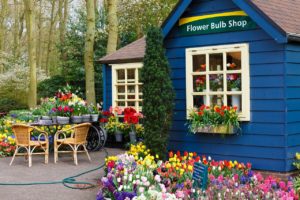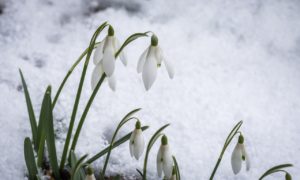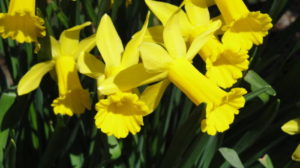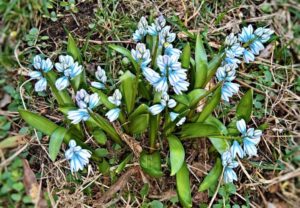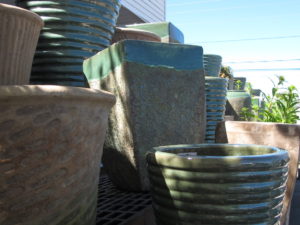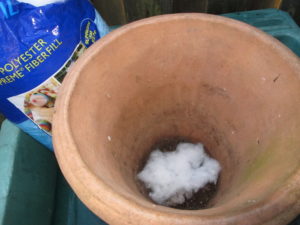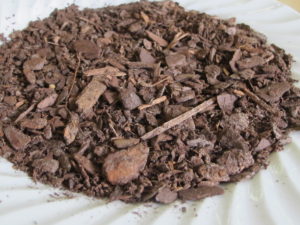“Good things come to those who wait.”
Everyone has heard this saying. Gardeners who plant spring-flowering bulbs in their gardens must necessarily agree. We’re a patient lot, and expect to wait for apples, for tomatoes, for fat mounds of ‘Great Expectations’ hosta. And we wait for spring.
We wait…and we watch. In fact, both of those words derive from the Anglo-French waiter, to watch over, and the earlier Old High German wahta, to watch.
And then, one day in January or February, maybe March where you live, the first of the early snowdrops’ nodding bells dare to defy ankle high snow. With the next break in the weather, snow crocuses reveal their sprightly blooms, followed by bold spears of early daffodils. When their cheery yellow trumpets open, they demand attention, proclaiming to the world, “We’re here!”
Daffodils bring life to a chilly landscape, and, at the same time, they assure us that spring is either here or near. Their warm colors—various shades of yellow, orange, salmon and peach—are a psychological cup of hot chocolate. But I also love the white and pink varieties. Fragrant ‘Bell Song’ is a favorite, with a light pink cup and white outer petals. ‘Mount Hood’ is a substantial and long-lasting variety, first creamy, then mostly white.
But, if digging in cold soil is not your cup of tea, perhaps another option will interest you. This alternative can be accomplished in the kitchen or the garage. Or on the back porch. And it won’t take long to do.
Potted Bulbs—The “Lasagna Pot”
This project involves growing spring-flowering bulbs in pots, planted close together. Blooms open in late winter, in some areas, and continue to please for weeks, or even months, afterward. Often called lasagna pots, they’re simply generously sized pots filled with layers of bulbs.
Because we don’t intend to keep the bulbs in the pots from year to year, it’s perfectly acceptable to space them so they’re almost touching. That’s how we get the most flowers. We do, however, want to place them close to the proper depth. Growth emerging from the bulbs is narrow and pointed, and it will easily find its way through the bulbs above them.
Suggestions For Types Of Bulbs To Use
Spring-flowering bulbs can be classified based on timing of bloom. Early, mid, and late spring bulbs keep the flowers coming for a long season of color. Snowdrops and snow crocuses are early, and larger Dutch crocuses bloom in early to mid spring. Hyacinth’s blooms scent the air in mid spring, followed by grape hyacinths, which continue to late spring. Many thousands of kinds of daffodils and tulips bloom early, mid, or late season, depending on variety.
Don’t overlook the minor bulbs or unusual varieties. It’s always fun to try something new. Check out Allium, Chionodoxa, Ipheion, Ornithogalum, Puschkinia, and Scilla. They’ll add another dimension at less cost than the same number of tulips, hyacinths, or daffodils. And, due to their small size, you plant them only a few inches deep.
See what the garden center is stocking this year, or consider the vast offerings from mail order sources. Keep in mind that the longer the bulbs stay at comfortable shopper-friendly temperatures in the stores, the more they dry up. So, purchase them soon after they become available in autumn, and keep them cool (under 50°F), but not freezing, until you plant them. Feel the bulbs, choosing those that are plump and firm.
Perfect Timing…Or Not
You can orchestrate a perfectly sequential roll-out of flowers, timed so three of these will follow or coincide with 5 of those. Looks good on paper…but in real life, potted bulbs respond, more or less, to their own internal clocks.
Don’t obsess over the timing. Use catalog descriptions as somewhat vague guidelines. Just enjoy the process, the anticipation, the flowers.
The Process
The Pot
First choose a pot. The larger it is, the more bulbs will fit. It should be deep enough to accommodate large tulips or daffodils, which will be planted about 8″ below the soil surface. Plan on about an inch between the top of the soil and the pot’s rim.
Look for pots that are frost resistant, or use plastic pots. The pot needs to have a drainage hole.
I chose a decorative clay pot, 12″ wide and deep. And there’s algae growing on the sides, adding a rustic element.
Two 10″ or 12″ plastic pots that fit into your ceramic pots by the front door can be planted now, and kept cool over the winter. When they begin to sprout, simply slip them into the pretty pots. Add preserved moss, colorful twigs, and a few pine cones to the inserts for a finished look. In late winter, you can add small violas, if there’s room, for more color. They’ll take the cold weather, up to zone 5 on the USDA plant hardiness zone map.
Polyester Fiberfill
Use a small handful of this synthetic fluffy material to cover the drainage hole. Water will drain through it, but the soil will stay inside the pot. I use it for all potted plants to prevent erosion, from 2″ clay pots for dwarf succulents up to the largest pots.
Another advantage is that polyester fiberfill prevents ants, earthworms, sowbugs, and other critters from crawling inside the pot through the drainage hole. Because it doesn’t rot, it can be used again. You’ll find it at any hobby or craft store.
I never add rocks or gravel in the bottom of the pots.
Potting Soil
Use fresh potting soil that drains well. Mix in pine fines or coarse sand if your soil is heavily composted and stays wet. Avoid using any kind of manure near the bulbs.
Add a few inches of soil to the bottom of the pot, and lightly firm it in. This is where the first of the bulbs will be planted, so measure the depth.
Not sure how deep to plant them? If in doubt, plant so the bottom of the bulb will be as deep in the soil as three times the height of the bulb. The small minor bulbs can be planted four or five times their height. But don’t stress over it; there’s some wiggle room when planting bulbs.
Headings
Page 1: “Good things come to those who wait.”, Potted Bulbs—The “Lasagna” Pot, Suggestions For Types Of Bulbs To Use (Perfect Timing…Or Not), and The Process (The Pot, Polyester Fiberfill, Potting Soil)
Page 2: Planting the Bulbs (Narcissus ‘Ice Follies’, N. ‘Pipit’, N. ‘Tête-à-Tête’, Brodiaea ‘Queen Fabiola’, Muscari ‘Dark Eyes’, and Crocus ‘Yellow Mammoth’), Mulch and Water, Caring for the Potted Bulbs, How Cold?, Can We Grow the Potted Bulbs Again?, and Update: Here’s How the Lasagna Pot Did This Spring
